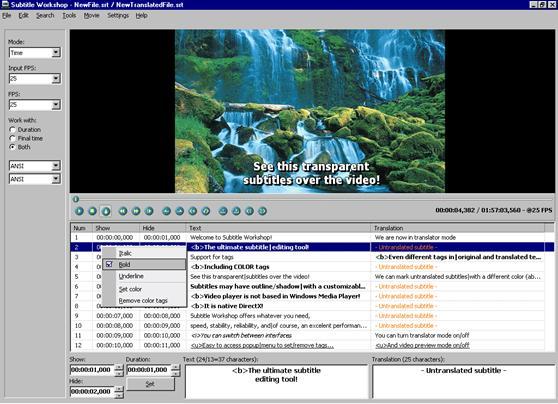Introduction
In the vibrant realm of media, the humble art of subtitling often goes unnoticed, yet its impact is profound. As the world becomes increasingly interconnected and diverse, subtitles have emerged as vital bridges, connecting audiences across linguistic and cultural divides. While some may perceive subtitling as a mere technical skill, it is an intricate craft that demands a keen eye, linguistic prowess, and cultural sensitivity.

Image: wondershare.com
If you are captivated by words and yearn to bridge communication gaps, a career as a subtitle writer may be your calling. This comprehensive guide will embark on a journey through the world of subtitling, exploring its history, nuances, and the essential steps to become a successful subtitle writer.
Subtitling: The Art of Translation in Motion
What is Subtitling?
Subtitling is the process of translating spoken dialogue into written text that appears on the screen during a video presentation. This text provides accessibility for deaf and hard-of-hearing individuals, language learners, and those watching in an unfamiliar language environment.
Types of Subtitles
Subtitles come in various forms to cater to different needs:
- Closed Captions: Captions that can be turned on or off by the viewer
- Open Captions: Captions that are permanently embedded in the video
- Foreign Language Subtitles: Translations of dialogue into languages other than the original

Image: www.pinterest.com
The Enchanting World of Subtitling
The art of subtitling is a fusion of technical proficiency and creative flair. Subtitles must be accurate, concise, and legible, yet they also need to flow seamlessly with the visual narrative, capturing the rhythm and tone of the original dialogue.
To succeed in this captivating field, aspiring subtitle writers should possess:
- Excellent writing and editing skills
- A strong understanding of linguistics and grammar
- Cultural sensitivity and awareness of intercultural communication
- Ability to work under tight deadlines and manage multiple projects simultaneously
Embarking on the Subtitle Writer’s Journey
Becoming a subtitle writer is an achievable goal with the right approach and dedication. Here’s a comprehensive roadmap to guide you:
- Education and Training: While formal education is not always a requirement, it can provide a solid foundation in the principles of subtitling. Consider pursuing a degree or certification in translation, linguistics, or a related field.
- Develop Strong Language Skills: Mastering the original language and target language is crucial. Proficiency in both written and spoken communication is essential.
- Immerse Yourself in Subtitling: Practice is the key to honing your craft. Start by creating subtitles for short videos or films, seeking feedback from peers and experienced subtitlers.
- Build Your Network: Connect with industry professionals at conferences, workshops, and online platforms. Join professional organizations and establish a presence in the subtitling community.
- Obtain Certification: Consider obtaining a recognized certification in subtitling, such as the Certified Professional Subtitler (CPS) credential from the Society for the Study of Captions and Subtitles.
- Accuracy and Faithfulness: Subtitles must accurately convey the meaning and intent of the dialogue, capturing nuances and emotions.
- Conciseness and Readability: Subtitles should be concise and easy to read, with a duration of approximately 2-4 seconds on screen.
- Synchronization and Timing: Subtitles must be synchronized with the speaker’s voice and align with the timing of the video.
- Cultural Adaptation: Subtitles should be adapted to the target audience’s cultural context, taking into account idioms, phrases, and references.
- SEO Optimization: For foreign language subtitles, consider using keywords and phrases relevant to the target audience’s language, enhancing searchability and accessibility.
- Read widely: Exposure to different writing styles, genres, and perspectives broadens your linguistic repertoire.
- Immerse yourself in the industry: Attend industry events, subscribe to trade publications, and engage in discussions on subtitling forums.
- Collaborate with directors: Communication with directors ensures subtitles align with the film’s narrative and pacing.
- Proofread meticulously: Careful proofreading eliminates errors and enhances the overall quality of your work.
- Stay up-to-date with technology: Embrace technological advancements in subtitling software, machine translation tools, and assistive technology.
Mastering the Craft of Subtitling
Becoming an exceptional subtitle writer requires ongoing refinement and mastery of specific techniques:
Expert Insights and Tips
Renowned subtitle writers offer valuable guidance for aspiring professionals:
Frequently Asked Questions
Q: What software do subtitle writers use?
A: Common software includes Subtitle Edit, Aegisub, and Premiere Pro.
Q: How much do subtitle writers earn?
A: Earnings vary depending on experience, project scope, and location.
Q: What are the career prospects for subtitle writers?
A: The demand for subtitle writers is steadily growing due to globalization and increased accessibility needs.
Q: Can I work as a freelance subtitle writer?
A: Yes, many subtitle writers work freelance, providing flexibility and the opportunity to collaborate with diverse clients.
Q: What resources are available for learning about subtitling?
A: Online courses, workshops, and industry publications offer valuable insights and practical knowledge.
How To Become A Subtitle Writer
Conclusion
Becoming a subtitle writer is a rewarding journey that combines technical expertise with creative expression. Whether you seek to bridge linguistic divides, enhance the accessibility of media, or simply ignite your passion for words, the world of subtitling beckons you. Embrace the challenge, immerse yourself in the craft, and let your words dance on the screen, bringing stories to life for audiences worldwide.
Are you ready to embark on the adventure of becoming a subtitle writer? Let your journey begin!